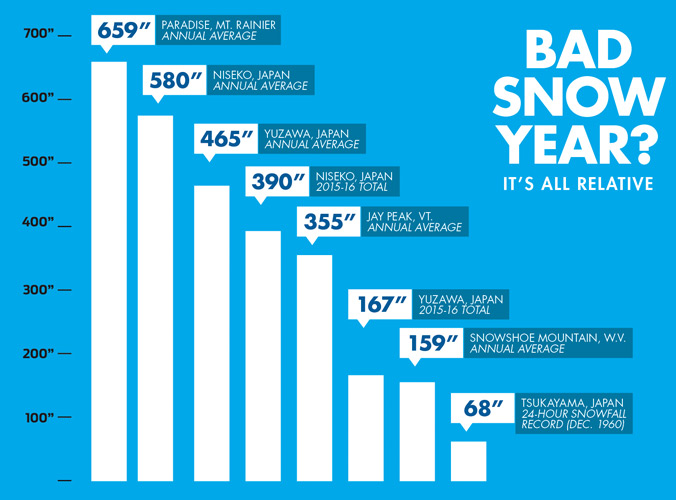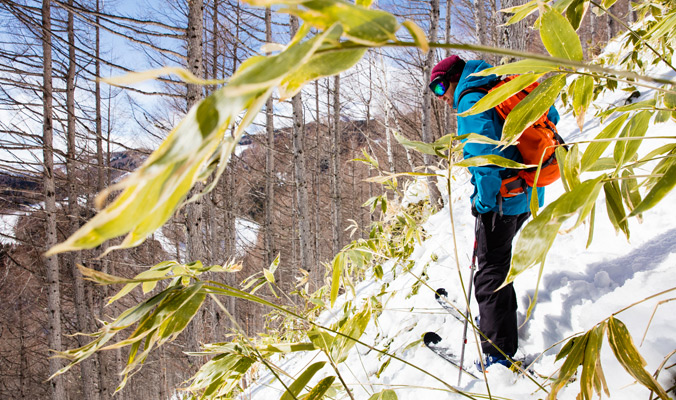For powder-seeking skiers, Japan has earned a sure-bet reputation for delivering deep, billowing powder. And for six years, ski photographer Grant Gunderson has made his way to the Pacific powder mecca with confidence, knowing that the trip would yield at least a few guaranteed money-making shots. But last winter, this wasn’t exactly the case.
Japan was experiencing record-low snowfall in January, and Gunderson got skunked on all but the final few days of his trip. “Last year was the least amount of snow that they have ever had on record. In fact when we got over there, it was completely unskiable,” Gunderson says. “To realize, ‘Oh, this is probably not going to work out,’ it was a bit of a shock.”
Winter temperatures hovering around freezing are not uncommon in Japan, and Gunderson admits to experiencing a little rain now and then on his past trips. But to be unable to ski seemed unheard of to Gunderson. So was last year an outlier or is this a sign of more unpredictable Japanese winters to come?

Tyge Shelby skis through exposed bamboo shoots on Mt. Norikura. | Nagano, Japan | Photo: Tyler Roemer
Snowfall everywhere is dictated by combining water with cold air. And according to Hiroaki Kawase, a climate scientist for the Japan Meteorological Agency’s Meteorological Research Institute, that cold air comes down to Japan from Eurasia—namely Siberia in winter—and collides with water vapor from the Sea of Japan.
“The Sea of Japan is very warm,” Kawase says, “so the cold, dry air from the continent picks up a lot of water vapor and dumps a lot of snow in the high mountains.”
The two main beneficiaries of that snowfall are the main island’s Hida Mountains, also known as the Japanese Alps, and the scattered peaks of Hokkaido, the north island. Even with this past winter hitting record-low snow totals, SnowJapan.com reports that Kiroro Resort on Hokkaido’s eastern coast received 45 feet of snow by April—15 feet falling in January alone—and Niseko, in southwestern Hokkaido, received a season total of 32.5 feet. (For comparison, the average annual snowfall in Niseko totals 50 feet—so a low-snow year is relative in the Land of the Rising Sun.)

Despite these numbers, climatologists are quick to point out that it is hard make generalizations about weather trends. Unpredictability, they explain, is the only thing they can predict.
“If you run forward 10, 20, 30 years, we actually have no idea what kind of fluctuations between these extremes we are likely to get,” says Dr. Alan Betts, an atmospheric scientist who studies climate fluctuations and their repercussions.
“What appears to be happening is that these extremes are getting larger, and they are getting larger on a global scale,” Betts explains. “In the last decade or so, these fluctuations have increased and have led to strong precipitation and flooding. They are leading to these extremes in winters.”
A spring 2016 study by the National Oceanic and Atmospheric Administration (NOAA) predicted that this year might continue recent record-breaking temperature trends and could become the hottest on record. It doesn’t take being a climatologist to realize this does not bode well for snowy environments, but understanding the nuances of climate change’s effects proves more difficult.

Tyge Shelby tries to find a line through the bamboo shwack. | Nagano, Japan | Photo: Tyler Roemer
That’s because coastal regions have their own unique reactions to global warming due to their proximity to large bodies of water and the currents that rule those oceans and seas. For example, Dr. Betts explains that on the East Coast of the United States, the Gulf Stream affects snowfall because of the existence of a boundary current. Say Betts, “The gradient between the warm Gulf Stream current and the temperature of the nearby continent is what drives the very strong storms and can give us a lot of snowfall in a winter situation.”
The Kuroshio Current is the Gulf Stream’s Japanese counterpart, and it brings equatorial waters to the eastern edge of Japan. And similar to the Gulf Stream, changes within the Kuroshio Current have the potential to dramatically affect Japan’s winter precipitation levels.

“In the coastal areas of Japan,” Kawase explains, “the snowfall will change to rainfall, but in the mountainous areas, from December through the end of January, the snowfall will increase because of an increase in water vapor evaporation from the Sea of Japan.”
In his co-authored article, “Altitude dependency of future snow cover changes over Central Japan evaluated by a regional climate model,” Kawase goes on to explain that across Japan, for the near future, precipitation levels and elevation will be directly linked. The study finds that when evaporation increases from the Sea of Japan due to warmer sea-surface temperatures, higher elevations see more snowfall when ambient temps drop below freezing. Lower elevations, without the advantage of colder air, will start to see a spike in rainfall.
Gunderson’s trip last winter highlights how moving to higher elevations might be the quick fix for those in search of snow in an off year. “We had to go 1,500 vertical feet higher in elevation than we normally ski over there,” he says. “But we did get a good storm in the last two days we were there to make it worthwhile.”
Over the long haul, however, Kawase is not optimistic for any elevation. “Total snowfall will decrease because of global warming,” he simply states.
So does last year’s record-low snowfall mean that Japan can no longer be considered a guarantee for epic snows in the future? While Gunderson admits to observing a pretty dramatic swing between winter 2014-15 and 2015-16, he remains optimistic. “The year before was a record year, so it has gone back and forth,” he explains. “I think last year was a fluke year in Japan.”
But as Allan Betts emphasizes, “Moving forward, expect extreme winters with lots of snow and winters with very little snow.”
—
To get the October Issue of Backcountry Magazine, visit backcountrymagazine.com/subscribe.











Perhaps we should stop thinking flying is our right?
Aviation Has one of the biggest CO2 contributuins.
Yet we still think it’s ok to fly to Chile in the summer, Japan in the winter and some heli/cat skiing in between, not to mention weekend city flights for some r&r. Time to really own up !
Agreed, brother. We shall all receive a flying credit for each year. And use it consciously. More on the topic: https://www.theguardian.com/environment/ng-interactive/2019/jul/19/carbon-calculator-how-taking-one-flight-emits-as-much-as-many-people-do-in-a-year